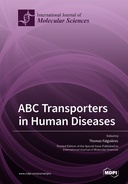Explore

ABC Transporters in Human Diseases
0 Ungluers have
Faved this Work
Login to Fave
Mammalian ATP-binding cassette (ABC) transporters constitute a superfamily of proteins involved in many essential cellular processes. Most of these transporters are transmembrane proteins and allow the active transport of solutes, small molecules, and lipids across biological membranes. On the one hand, some of these transporters are involved in drug resistance (also referred to as MDR or multidrug resistance), a process known to be a major brake in most anticancer treatments, and the medical challenge is thus to specifically inhibit their function. On the other hand, molecular defects in some of these ABC transporters are correlated with several rare human diseases, the most well-documented of which being cystic fibrosis, which is caused by genetic variations in ABCC7/CFTR (cystic fibrosis transmembrane conductance regulator). In the latter case, the goal is to rescue the function of the deficient transporters using various means, such as targeted pharmacotherapies and cell or gene therapy. The aim of this Special Issue, “ABC Transporters in Human Diseases”, is to present, through original articles and reviews, the state-of-the-art of our current knowledge about the role of ABC transporters in human diseases and the proposed therapeutic options based on studies ranging from cell and animal models to patients.
This book is included in DOAB.
Why read this book? Have your say.
You must be logged in to comment.
Rights Information
Are you the author or publisher of this work? If so, you can claim it as yours by registering as an Unglue.it rights holder.Downloads
This work has been downloaded 101 times via unglue.it ebook links.
- 101 - pdf (CC BY) at Unglue.it.
Keywords
- 5′ untranslated region
- AAV
- ABC
- ABC (ATP-binding cassette) transporters
- ABC transporter
- ABC transporters
- ABCA subfamily
- ABCA7
- ABCB1
- ABCB11
- ABCB4
- ABCC2
- ABCC6
- ABCG2
- ABCG2 genotype
- ABCG5
- ABCG5/G8
- ABCG8
- adrenoleukodystrophy
- Alzheimer’s disease
- amyloid-beta
- anticancer
- antifungal resistance
- Atherosclerosis
- ATP-binding cassette transporter
- ATP-binding cassette transporter A1 (ABCA1)
- Aβ peptides
- BCRP
- beta-amyloid
- bile salts
- bile secretion
- Bioinformatics
- Biology, Life Sciences
- Blood-Brain Barrier
- Breast cancer
- BRIC
- BSEP
- Calcification
- cAMP
- Cancer
- cellular ATP efflux
- chaperones
- cholesterol
- cholesterol homeostasis
- cis-acting elements
- clinico-genetic analysis
- competitive allele-specific PCR
- disease-free survival
- drug action
- drug transport
- dyslipidemia
- early-onset gout
- erlotinib
- ethnic specificity
- Fatty acids
- functional divergence
- gall stone
- Gene Therapy
- generalized arterial calcification of infancy
- genetic variations
- gout
- HDL-C
- homology modeling
- hyperuricemia
- intracellular traffic
- intrahepatic cholestasis
- Invasion
- Mathematics & science
- MDR3
- Mechanism
- mechanism of action
- membrane protein
- microparticles
- migration
- molecular partners
- MRP1
- MRP4
- multidrug resistance
- multidrug transporter
- mutagenesis
- Mutations
- n/a
- Neuron
- next-generation sequencing
- NT5E
- P-Glycoprotein
- peroxisome
- pet
- PFIC
- PFIC2
- Phagocytosis
- phosphatidylcholine
- phytosterol
- polar relay
- polymorphisms
- precision medicine
- proliferation
- pseudoxanthoma elasticum
- Pseudoxanthoma elasticum (PXE)
- Pyrophosphate
- RAB GTPase
- rare variant
- Reference, information & interdisciplinary subjects
- regulatory extension
- regulatory insertion
- Research & information: general
- reverse cholesterol transport
- Roma
- serum uric acid
- Single nucleotide polymorphism
- sitosterolemia
- SK-N-SH
- SNP
- SUA-lowering therapy
- substrate-binding site
- tariquidar
- taxol
- therapies
- therapy response
- TNAP
- trafficking
- transport
- transporter
- type 2 diabetes
- urate
- urate transporter
- uric acid
- xenosterol
- Yeast
Links
DOI: 10.3390/books978-3-0365-3943-0Editions

